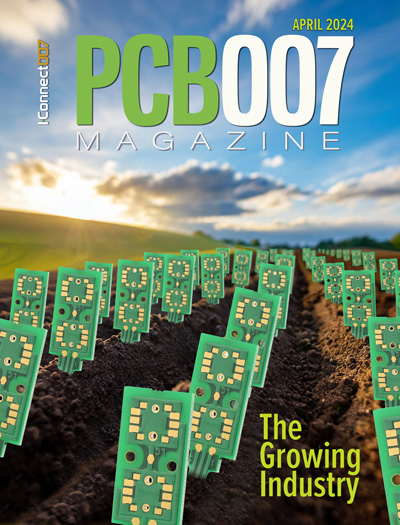-

- News
- Books
Featured Books
- pcb007 Magazine
Latest Issues
Current Issue
The Growing Industry
In this issue of PCB007 Magazine, we talk with leading economic experts, advocacy specialists in Washington, D.C., and PCB company leadership to get a well-rounded picture of what’s happening in the industry today. Don’t miss it.

The Sustainability Issue
Sustainability is one of the most widely used terms in business today, especially for electronics and manufacturing but what does it mean to you? We explore the environmental, business, and economic impacts.

The Fabricator’s Guide to IPC APEX EXPO
This issue previews many of the important events taking place at this year's show and highlights some changes and opportunities. So, buckle up. We are counting down to IPC APEX EXPO 2024.
- Articles
- Columns
Search Console
- Links
- Events
||| MENU - pcb007 Magazine
Happy’s Essential Skills: Design for Manufacturing and Assembly, Part 2
June 30, 2016 | Happy HoldenEstimated reading time: 9 minutes
Editor's Note: This is the second part of Happy’s Essential Skills: Design for Manufacturing and Assembly column, CLICK HERE for the first part.
The Role of Metrics For Predicting and Planning
Metrics are data and statistically backed measures, such as T-downs, Connectivity, Wiring Demand, Wd. These measures can be density, connectivity or in this context, producibility. These measures are the basis for predicting and planning. When used in the design process, there are three categories of measures applied to a product. Only the metrics can be shared by all in the design team. The non-metrics provide little assistance in design:
Metrics
* Metrics: Both the product and the process are measured by physical data using statistical process control (SPC) and total quality management (TQM) techniques. (Predictive Engineering Process)
* Figure of Merit: Both the product and the process are scored by linear equations developed by consensus expert opinion. (Expert Opinion Process)
Non-Metrics
* Opinion: Opinion, albeit from an expert, is applied after or concurrent with design. (Manufacturing Engineering Inspection Process)
* No Opinions: No attempt to inspect or improve the design is done during the specification, partitioning, or design stage. (Over The Wall Process)
Metrics also establish a common language that links manufacturing to design. The "producibility scores" form a non-opinionated basis that allows a team approach that results in a quality, cost competitive product (Figure 8). Metrics allows design to progress through the “Engineering Design Ages.”
- Age of Anarchy (60%): anything goes.
- Age of folklore (25%): Wisdom is passed from one generation to another, over pizza and beer.
- Age of Methodology (10%): The way DFM is to be engineered is documented, and is actually done that way, using Figures of Merit.
- Age of Metrics (4%): Both the product and the process are measured in standard ways.
- Age of Engineering (1%): Productivity is achieve through continuous quality improvement, much like it is in manufacturing.
Figure 8: The benefits of metrics as a common design language.
The strategy in applying these measures is shown in Figures 9 and 10. The analysis process is unique to every individual and company, but certain conditions have to be met and considered if the product is going to be successful. If the score meets producibility requirements then select this approach, if not, then evaluate other opportunities and repeat the process. In the rest of this column, measures and metrics will be introduced that provide insight for layout, fabrication and assembly planning.
Non-Metrics
It is always preferred to have metrics when discussing producibility. But if metrics are not available, then the opinions of experts are better than nothing (no opinions). The problem with opinions is that they are difficult to defend and explain and, when used in conjunction with producibility, many times they vary with each person. Sometimes, the opinion process is implemented for good intentions by taking experienced production experts and having them review a new design. This is the expert opinion process and although it is sometimes successful, it is difficult to replicate and many times results in building barriers between manufacturing and design. That is why the Figure Of Merit Process is so popular. For a small amount of work by experts it produces a scoring procedure that can be used and understood by all. This was detailed in the last column, #9.
Figure 9: Process using “use of measures and metrics” to match a company’s design process to its manufacturing process and support culture.
Figure 10: Process to develop a Manufacturability Metric as a substitute for opinions.
Page 1 of 3
Suggested Items
Real Time with... IPC APEX EXPO 2024: Exploring IPC's PCB Design Courses with Kris Moyer
04/18/2024 | Real Time with...IPC APEX EXPOGuest Editor Kelly Dack and IPC instructor Kris Moyer discuss IPC's PCB design training and education offerings. They delve into course topics such as design fundamentals, mil/aero, rigid-flex, RF design, and advanced design concepts. They also highlight material selection for high-speed design, thermal management, and dissipation techniques. The interview wraps up with details about how to access these courses online.
Cadence Unveils Palladium Z3 and Protium X3 Systems
04/18/2024 | Cadence Design SystemsThe Palladium Z3 and Protium X3 systems offer increased capacity, and scale from job sizes of 16 million gates up to 48 billion gates, so the largest SoCs can be tested as a whole rather than just partial models, ensuring proper functionality and performance.
Signal Integrity Expert Donald Telian to Teach 'Signal Integrity, In Practice' Masterclass Globally
04/17/2024 | PRLOGDonald Telian and The EEcosystem announce the global tour of "Signal Integrity, In Practice," a groundbreaking LIVE masterclass designed to equip hardware engineers with essential skills for solving Signal Integrity (SI) challenges in today's fast-paced technological landscape.
On the Line With... Podcast Talks With Cadence Expert on Manufacturing
04/18/2024 | I-Connect007In “PCB 3.0: A New Design Methodology: Manufacturing” Patrick Davis returns to the podcast to talk about design rules. As design considerations become more and more complex, so, too, do the rulesets designers must abide by.
Designing Electronics for High Thermal Loads
04/16/2024 | Akber Roy, Rush PCB Inc.Developing proactive thermal management strategies is important in the early stages of the PCB design cycle to minimize costly redesign iterations. Here, I delve into key aspects of electronic design that hold particular relevance for managing heat in electronic systems. Each of these considerations plays a pivotal role in enhancing the reliability and performance of the overall system.


